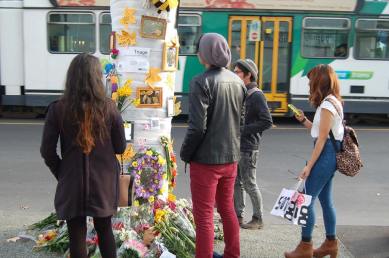In my past blog posts, I have considered various emerging aspects of media which have posed challenges to the concept of journalism – Wikileaks, YouTube, Selfies, Reddit – the list goes on. The cultural public sphere is creating new ways for society to engage in discussion of current issues, and themselves create news content. This culminated in the question “what is the future of journalism”? The answer to that was, in summary, innovation. I would like to conclude this idea of where journalism is headed by developing the idea of aesthetic journalism, and how it can play a role in counteracting the effects of having what may be perceived as “too much information”.
Aesthetic journalism is the exploration of social, cultural and political issues expressed through various art forms which produce a more tangible experience for the audience (Cramerotti, 2011). The purpose is to evoke an emotive, thoughtful response in the viewer, rather than informing them of fact situations. It is a way of transforming meaning, of processing everyday lived reality in a variety of ways. Instead of simply absorbing information, the audience is encouraged to question the content put before them.
If we think about how journalism is evolving through user-generated information on a global scale, it is not so surprising to think that aesthetic journalism may have a larger role to play in giving audiences a more authentic experience of their world. Increased user participation means increased sources of information, which in turn means sources become less reliable. This may be an unintentional flow on effect of participatory media, but nevertheless it is the case that journalism needs an avenue of re-authenticating the news experience.
Much of this occurs within the space of exhibitions. From March to May 2014, a free exhibition titled “We Are Family” is on at the Australian Centre for Photography. In summary it is a collection of photos which challenge the idea of the “family”, and depict constructions of “family” from the perspective of gay, lesbian, bisexual, transgender, intersex and queer contexts.
This exhibition carries strong messages on current issues facing society today. It causes the viewer to stop and absorb all the different perspectives, and question their own understanding of what family means. This is aesthetic journalism in practice. It comes at a time when such policy issues as gay marriage are constantly circulating in the media. Instead of simply throwing information out there about the GLBTIQ community, the exhibition creates a much more subtle and reflective experience of current issues. There is much knowledge to be gained from this exhibition, but it is for the viewer to tease out these ideas and give them meaning.
 A more localised example of aesthetic journalism was created by Melbourne artist Louise Lavarack in her display ”Triage” – a 30-year-old tree in Melbourne that was covered in cotton wool and gauze bandages to draw attention to the growing issue of tree vandalism in the area. This project brought to light an issue, which perhaps people were aware of, but did not really consider in depth. Whilst a news article on the growing number of vandalized trees might make people concerned or angry, this public display evokes an emotive response. It makes the individual pause for a moment and consider what the issue means for their community.
A more localised example of aesthetic journalism was created by Melbourne artist Louise Lavarack in her display ”Triage” – a 30-year-old tree in Melbourne that was covered in cotton wool and gauze bandages to draw attention to the growing issue of tree vandalism in the area. This project brought to light an issue, which perhaps people were aware of, but did not really consider in depth. Whilst a news article on the growing number of vandalized trees might make people concerned or angry, this public display evokes an emotive response. It makes the individual pause for a moment and consider what the issue means for their community.
References:
Cramerotti, Alfredo, 2011, Aesthetic Journalism: How to Inform Without Informing, Intellect, London.
Image sources:
http://sydney.concreteplayground.com.au/event/184430/we-are-family-and-s-m-wonderland.htm
http://www.peterburke.com.au/news/2013/7/31/triage-the-bandaged-tree.html